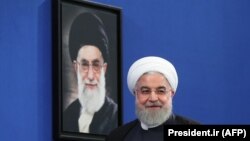Beyond the shadow of a doubt, the Islamic Republic Supreme Leader Ayatollah Khamenei bears the highest responsibility, followed by President Hassan Rouhani, for the order to use deadly force against people who poured into the streets to protest an unexpected overnight three-fold increase in gasoline prices on November 15.
Based on the Islamic Republic Constitution, Iran's Supreme National Security Council (SNSC), presided over by the President, oversees countering anti-establishment protests and dealing with national political crises. The SNSC, assisted by the country's National Security Council (NSC), has access to all tools needed for suppressing widespread demonstrations.
The Constitution stipulates that, at the time of national unrest, SNSC decides the methods and tools required for controlling anti-regime rallies.
Furthermore, SNSC is able to deploy all military forces, including the members of the police, the regular army, the Islamic Revolution Guards Corps, as well as the militia and armed plainclothesmen to end all protests with an iron fist. The "supreme council" also has the authority to decide on the type of weapons, including aircraft, tanks, and RPGs, that might be used against the protesters.
The country's National Security Council (NSC), headed by the Minister of Interior, Abdol Reza Rahmani Fazli, is practically a subdivision of the SNSC, implementing its guidelines.
Meanwhile, the head of the SNSC, the country's President, may delegate to the head of NSC to preside over the supreme council (SNSC) on his behalf.
That's what happened almost immediately after the widespread anti-regime demonstrations that broke out on November 15. The Interior Minister, assigned by the President, took control of the SNSC to take steps for controlling the fast-expanding protest movement.
As the caretaker of the SNSC, Rahmani Fazli decided on November 16 to shut down the internet across Iran to prevent protesters from linking-up with each other as well as being able to freely upload footage of the unrest and circulate it on social media all over the world.
Although it is still unclear if the SNSC, under Rahmani Fazli's temporary leadership, endorsed opening fire at protesters, Rouhani's responsibility in the recent massacres remains a fact.
Above Rouhani, the Islamic Republic Supreme Leader Ayatollah Khamenei is also responsible for the brutal suppression and killing of protesters since he has the last word on major national affairs, without being accountable to anyone.
Article 176 of the Islamic Republic Constitution stipulates that the Supreme Leader is the leading authority in Iran, and none of the SNCS' rulings and decisions are implementable without his blessing and confirmation.
Therefore, Ayatollah Khamenei is directly responsible for the shutdown of the internet across the country and killing dozens of people who merely protested the shocking hike in gasoline prices.
Furthermore, Khamenei is responsible also because he is commander-in-Chief of Iran’s armed forces.
Based on Article 110 of the Islamic Republic Constitution, the armed forces that fired at demonstrators and killed dozens were merely obeying orders issued by the Supreme Leader.
Following Khamenei and Rouhani, nearly thirteen other civil and military officials are also responsible for the recent bloodshed and detention of thousands.
These include all members of the SNSC; its Secretary the IRGC Rear Admiral Ali Shamkhani, the representative of the Supreme Leader to the influential body Saeid Jalili, the members of the NSC, the speaker of Majles (parliament) Ali Larijani, the head of the Judiciary Ebrahim Raeesi, the head of Plan and Budget Organization Mohammad Baqer Nobakht, the Interior Minister Abdol Reza Rahmani Fazli, the Foreign Minister Mohammad Javad Zarif, the Minister of Intelligence Mahmoud Alavi, the Commander of the General Staff of Armed Forces of the Islamic Republic, IRGC Major General Mohammad Hossein Baqeri (Bagheri), and the Chief Commander of the IRGC Major General Hossein Salami.
According to Article 176 of the country's Constitution, the Chief Commanders of the regular Army and the IRGC are not fixed members of the SNSC but attend its sessions on affairs related to their duties.
Meanwhile, the role of several SNSC members in suppressing protesters and anti-regime demonstrators is more crucial than their counterparts. For example, the Minister of Interior Rahmani Fazli played a decisive and direct role in shutting down the internet, placing more pressure on the protesters.
Moreover, the governors across Iran are also directly under the Interior Minister's command, implementing his orders.
It also goes without saying that parallel intelligence apparatuses, notably the IRGC's, have always played a decisive role in killing and detaining thousands of people who dare to challenge the clergy-dominated ruling establishment.










